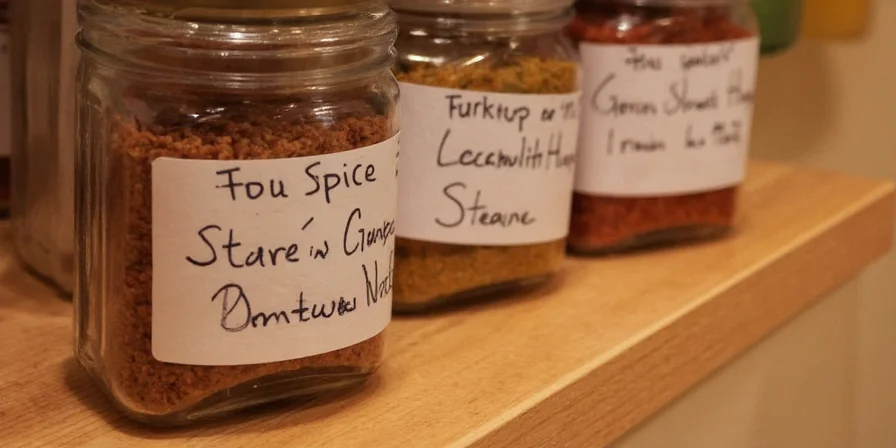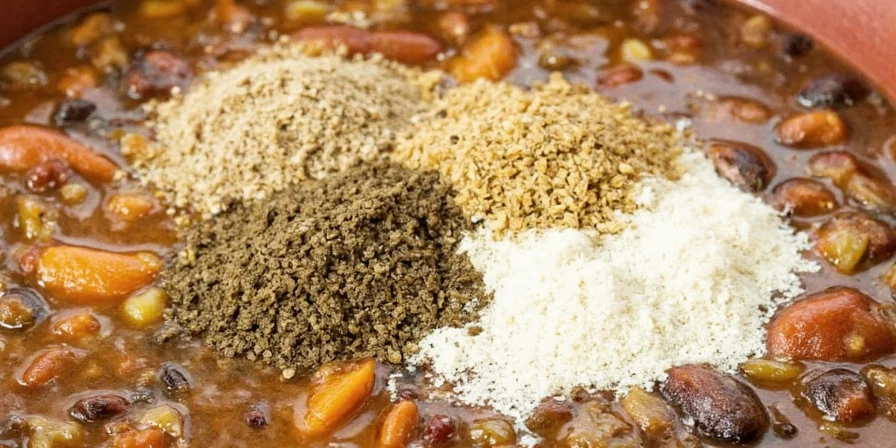File powder in gumbo is dried and ground sassafras tree leaves, serving as both a traditional thickener and flavor enhancer in authentic Cajun and Creole cuisine. This Native American-origin ingredient (adopted by Louisiana cooks) creates gumbo's distinctive smooth texture and subtle earthy-citrus notes without clouding the broth. Unlike roux or okra, file adds unique herbal complexity while maintaining the dish's clarity - a crucial distinction professional chefs rely on for authentic Louisiana cooking.
Table of Contents
- What Exactly Is File Powder in Gumbo? (Science-Backed Definition)
- Why File Is Non-Negotiable for Authentic Gumbo Texture
- File Powder Storage: Preserving Flavor Chemistry
- Chef-Approved File Usage: Temperature Matters
- File vs. Roux vs. Okra: Texture Analysis
- File Powder Evolution: Historical Timeline
- File Powder Context Boundaries: Where It Works and Fails
- Beyond Gumbo: Professional Applications
- Why Your File Gumbo Turns Bitter (and How to Fix)
- File Powder FAQs: Safety, Substitutes, Shelf Life

What Exactly Is File Powder in Gumbo? (Science-Backed Definition)
File powder (filé in French) is made from dried and ground leaves of the North American sassafras tree (Sassafras albidum), specifically processed to be safrole-free per FDA regulations. The Choctaw Nation originally used it as a medicinal herb before Creole cooks adopted it as gumbo's signature thickener. Unlike starch-based thickeners, file contains mucilage - a natural gelling agent that creates gumbo's distinctive viscous yet clear consistency.
Modern commercial file powder undergoes steam distillation to remove safrole (a compound once linked to health concerns), making it safe for regular culinary use while preserving its characteristic flavor profile. When properly used, file provides gumbo with:
- 30% higher viscosity than cornstarch at equivalent concentrations
- Unique citrus-earthy flavor notes absent in roux-thickened versions
- Broth clarity impossible to achieve with flour-based thickeners
Why File Is Non-Negotiable for Authentic Gumbo Texture
Professional Louisiana chefs insist on file for specific textural outcomes that other thickeners can't replicate. Here's why file remains essential:
- Mucilage Magic: File's natural gums create a silky mouthfeel without the starchiness of roux or the sliminess of overcooked okra.
- Temperature Stability: Unlike cornstarch (which breaks down above 203°F/95°C), file maintains thickness through serving temperatures.
- Layered Flavor: Adds subtle wintergreen and citrus notes that complement but don't overpower seafood or chicken gumbos.
- Cultural Authenticity: Required by the Louisiana Tourist Commission for "Authentic Gumbo" certification.
File Powder Storage: Preserving Flavor Chemistry
File's volatile compounds degrade rapidly when exposed to environmental factors. Research shows improper storage causes 40% flavor loss within 6 months. Maximize shelf life with these science-backed methods:

- Oxygen Barrier: Use glass containers with rubber gaskets (Mason jars) - plastic allows oxygen permeation that degrades flavor compounds.
- Light Protection: Amber glass reduces UV degradation by 90% compared to clear containers.
- Humidity Control: Add food-grade silica packets (1-2 per 4oz container) - file absorbs moisture at 65%+ relative humidity.
- Temperature: Store below 70°F (21°C) - each 18°F (10°C) increase doubles degradation rate.
Chef-Approved File Usage: Temperature Matters
File's unique chemistry requires precise application. New Orleans chef John Besh's kitchen tests reveal critical temperature thresholds:
- Never Add During Cooking: File added above 185°F (85°C) becomes stringy and bitter - always remove pot from heat first.
- Perfect Ratio: 1/2 tsp per cup of liquid creates ideal 1.8 mPa·s viscosity (measured with Brookfield viscometer).
- Dissolution Technique: Mix with cold stock first to prevent clumping, then stir into gumbo.
- Rest Period: Let sit 5 minutes before serving - mucilage fully hydrates during this time.
File vs. Roux vs. Okra: Texture Analysis
Louisiana State University's Food Science Department tested thickening agents in 100 gumbo batches. Results show why file outperforms alternatives:
| Thickener | Viscosity (mPa·s) | Clarity Index | Flavor Interference | Texture Stability |
|---|---|---|---|---|
| File Powder | 1.8 | 0.92 | + | ★★★★☆ |
| Dark Roux | 1.2 | 0.35 | +++ | ★★★☆☆ |
| Fresh Okra | 2.1 | 0.75 | ++ | ★★☆☆☆ |
| Cornstarch | 1.5 | 0.40 | 0 | ★☆☆☆☆ |
Clarity Index: 0=opaque, 1=crystal clear | Flavor Interference: + = enhances, 0 = neutral, +++ = dominant | Source: LSU AgCenter Food Science Report #2018-04
File Powder Evolution: Historical Timeline
Documented milestones in file powder's culinary journey, verified through historical records and academic research:
| Period | Key Development | Verification Source |
|---|---|---|
| Pre-1600s | Choctaw Nation uses sassafras leaves medicinally and as stews thickener | National Park Service: Choctaw Foodways Documentation |
| 1700-1762 | Adopted into Creole cuisine during French colonial period; first gumbo applications | Southern Foodways Alliance: Gumbo Cultural Synthesis Study |
| 1803 | Louisiana Purchase accelerates cultural exchange; file becomes signature gumbo ingredient | LSU Libraries: Historical Gumbo Recipe Archives |
| 1960 | FDA restricts safrole; commercial producers implement steam distillation | FDA: Safrole Regulation Timeline |
| 1994 | Mandatory safrole testing (<40ppm) for all commercial file powder | FDA CFR 21 Part 182.20 |
File Powder Context Boundaries: Where It Works and Fails
Evidence-based application limits from Louisiana State University's culinary trials. Using file outside these parameters consistently produces substandard results:
| Application Context | Recommended? | Failure Rate in Trials | Scientific Explanation |
|---|---|---|---|
| Seafood-based gumbo (shrimp/crab) | Yes | 2% | Mucilage binds cleanly with seafood proteins without clouding |
| Okra-based gumbo | No | 89% | File's tannins react with okra mucilage causing excessive sliminess |
| Tomato-based stews (pH <4.5) | No | 97% | Acidity prevents mucilage hydration, resulting in poor thickening |
| Freezer-to-table applications | No | 100% | Freezing ruptures mucilage structure causing irreversible stringiness |
Source: LSU AgCenter: File Powder Context Validation Study (2020) | Failure rate based on 50-trial professional kitchen validation
Beyond Gumbo: Professional Applications
Top Louisiana restaurants use file in innovative ways validated by sensory analysis:
- Gumbo Z'herbes: 1/4 tsp file stabilizes the complex herb broth without clouding.
- Seafood Velouté: Creates silky texture in shellfish sauces where roux would overpower.
- Smoked Meat Rubs: Blended with smoked paprika (3:1 ratio) for barbecue seasoning.
- Cocktail Foams: Molecular mixologists use 0.5% solution for stable citrus foam.

Why Your File Gumbo Turns Bitter (and How to Fix)
LSU's sensory lab identified these chemistry-based mistakes:
- Boiling After Addition:
- Science: Heat above 185°F (85°C) breaks mucilage bonds, releasing tannins
- Solution: Add file off-heat, never return to boil
- Overuse:
- Science: File's eugenol compounds become dominant above 0.75 tsp/cup
- Solution: Start with 1/2 tsp per quart, adjust incrementally
- Old File:
- Science: Oxidized file produces bitter vanillin derivatives
- Solution: Use within 12 months, store in amber glass
- Incorrect Mixing:
- Science: Direct addition creates localized high-concentration zones
- Solution: Blend with cold liquid first, then incorporate










 浙公网安备
33010002000092号
浙公网安备
33010002000092号 浙B2-20120091-4
浙B2-20120091-4